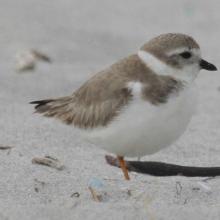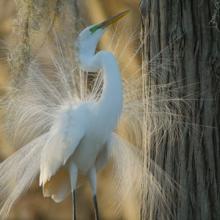

Join BirdNote tomorrow, November 30th!
Illustrator David Sibley and actor H. Jon Benjamin will face off in the bird illustration battle of the century during BirdNote's Year-end Celebration and Auction!
Striking a balance between the needs of threatened birds and humans isn't always easy.

On a May morning, a brilliant sun shines down on a Connecticut shoreline. Flocks of shorebirds, some of them state or federally threatened, swoop onto deserted beaches with few visible signs that humans were ever part of the picture. To the north, a salt marsh punctuated by the white dots of Great Egrets fishing in the tidal flats sustains the illusion of a place people somehow missed.
Welcome to Pleasure Beach, 77 acres at the tip of a small peninsula that boasts one-fifth of Connecticut's undeveloped barrier beaches. The controversy surrounding this tiny slice of nature underscores the daunting political challenge of reconciling human interests with those of threatened and endangered species.
This place's complicated geography poses unique challenges. The peninsula is shaped roughly like a tall witch's hat lying on its side. A narrow channel that you could easily swim across separates the brim from Bridgeport's mainland. The top three-quarters of the hat is Long Beach West, little more than a sandy walking path with a public beach on one side and a pristine—and mostly federally protected—salt marsh on the other. Bridgeport's northeastern neighbor, Stratford, a comparatively white, middle-class community with strong working-class roots and a long industrial history that includes making Sikorsky helicopters, owns Long Beach West. Every year thousands from the town flock to the shore during the hot summer months to swim in Long Island Sound.

That pedestrian path from the Stratford portion of the peninsula widens as it leads northwest to Pleasure Beach proper, a rough rectangle strewn with the ruins of what was once a thriving amusement park. To get there, walkers cross the border into Bridgeport, Connecticut's biggest city, populated largely by Hispanic and African-American communities. In December unemployment in the city, a former industrial powerhouse, was 11.7 percent, compared with 8.5 percent nationally. During both World Wars the munitions turned out by Bridgeport factories made it an "arsenal of democracy," but now those factories are empty hulks that remind unemployed residents of the jobs that have left.
At Pleasure Beach, the recreational facilities that gave this place its name—and made it a magnet for generations of tourists—are now either gone or dilapidated and covered with graffiti. Standing on the weathered bridge, you can see, 500 feet away across the waterway, the welter of industrial structures that line Bridgeport's shore. They form a gateway to a gritty and proud neighborhood where memories of happy weekends on these beaches are shared only by the city's older generation.
The wooden swing bridge that connected Pleasure Beach to Bridgeport burned in 1996, the victim, perhaps, of a carelessly dropped cigarette. Since then this onetime entertainment center, with a famous carousel and a ballroom that, at its peak in the 1940s, hosted the orchestras of Gene Krupa and Artie Shaw, has stood quietly apart from the city it once served. Without the lifeline of that bridge to the beach, people who live steps away face nothing but closed-off industrial docks. For these residents the now-gated Pleasure Beach may as well be on the moon.
The beach has nonetheless always been a boon to birdlife. In 2008 Audubon Connecticut designated Pleasure Beach, the salt marsh (most of which is part of the Stewart B. McKinney National Wildlife Refuge), and Stratford's Long Beach West an Important Bird Area (IBA). Audubon Connecticut executive director Tom Baptist describes the place, collectively known as the Stratford Great Meadows Important Bird Area, as "a network of essential habitats."
For Baptist, this living habitat is proof that preservation begins locally. "Too often when we think about conservation, we think about faraway places like the Amazon rainforest, Australia's Great Barrier Reef, or the Arctic," he says. "The truth is, we have globally significant conservation opportunities right here at home."

Baptist points out that the barrier beach hosts hundreds of bird species, provides a sheltered nursery for shell and finfish, filters Long Island Sound water, and prevents shoreline flooding. "It's one of the most important barrier beaches in Connecticut because of its size, length, bird diversity, and the critically important marsh that abuts it and that it protects," he says.
Least Sandpipers and Greater Yellowlegs wheel overhead on their way to their Canadian nesting grounds, and Ospreys circle with branches in their talons, ready to make their nests on towers required by the U.S. Fish and Wildlife Service.
The main avian attraction is the variety of birdlife, which includes federally threatened Piping Plovers and Least Terns (state listed as threatened), species suffering from population declines and protected by a patchwork of agencies. "We have been hoping for a bumper crop of terns and plovers this year, and an exciting nesting season," Patrick Comins, director of bird conservation for Audubon Connecticut, said in 2011. By mid-July there were 10 pairs of Piping Plovers and 15 pairs of Least Terns. While that was up from the 2010 season, it wasn't the 1,000 pairs of terns and double-digit plovers on the wish list. Comins suspects that what's kept the populations from surging are predators, including foxes, coyotes, and gulls, as well as flooding, erosion, and human disturbance.
Originally published in Audubon Magazine Published: March-April 2012 http://www.audubonmagazine.org
http://www.audubonmagazine.org/articles/conservation/pleasure-beach-pla…
Check out these BirdNote shows about Patrick Comins:
Piping Plovers on the Beach - Interview with Patrick Comins
Environmental Success at Long Beach - Patrick Comins
Patrick Comins, on Being a Conservationist
People Caring for IBAs - With Patrick Comins




